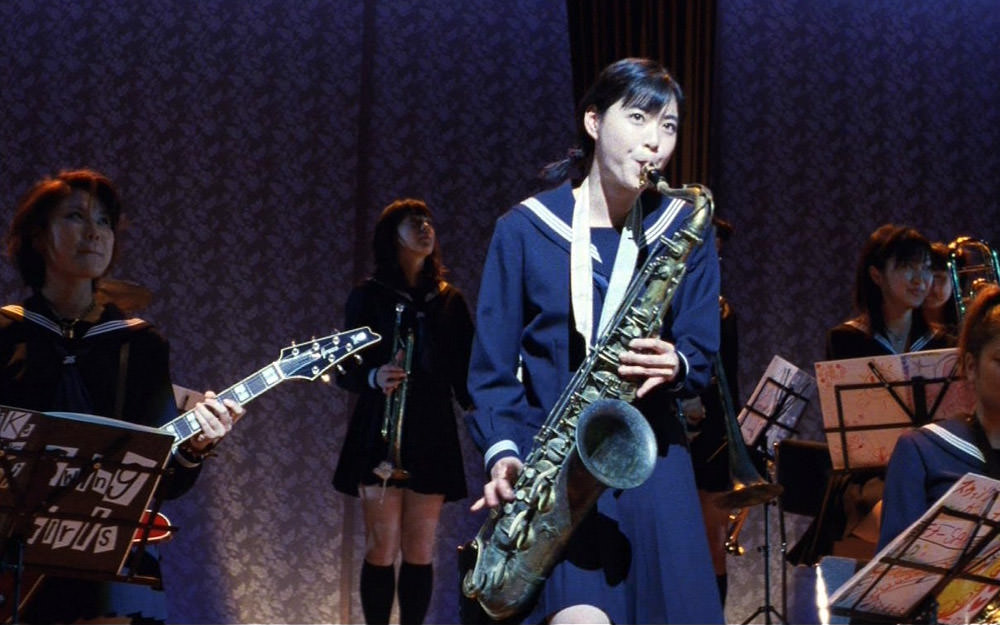Swing Girls by Shinobu Yaguchi (Review)

School’s out for the summer — except, that is, for a group of schoolgirls attending a remedial math class that none of them care about. While their teacher drones on in the morning heat, one of students — a girl named Tomoko — stares out the window, daydreaming. She casually observes the school’s beloved brass band as they leave to help cheer on the school’s equally beloved baseball team as well as the deliveryman who arrives too late with the band’s lunches.
Seeing a chance for her and her classmates to escape their teacher’s lecturing, Tomoko volunteers to bring the lunches to the band as a show of school spirit. Naturally, the girls are much more interested in having the day off than in actually helping out the band, and so take their time with the delivery. By the time they finally deliver the lunches, it’s too late. The food has become spoiled, and the band quickly succumbs to a severe case of food poisoning.
The only survivor is a reluctant young man named Yuta who is charged with putting together an interim band until the “real” band can recover. Despite blackmailing the Tomoko and all of the other girls into helping him, Yuta still doesn’t have enough students to make a brass band proper, and so he improvises, deciding to start a swing jazz band instead.
Up until now, Swing Girls has been moving at a fairly leisurely pace, with a few little humorous asides thrown in here and there to establish the various outrageous characters. However, as the swing band takes shape, the film slowly begins kicking things into high gear; the girls learn to love the music they’re being forced to play, work their butts off to earn enough money to buy instruments, and struggle to be taken seriously as musicians even after the real band returns from the hospital.
At it’s core, Swing Girls is essentially a stereotypical sports movie, and as such, you can basically guess every single story element and plot twist that will pop up throughout the film’s 105 minutes. There’s the group of unruly misfits thrown together by outrageous circumstances and forced to train under a reluctant/unrelenting coach figure, who bond together during grueling circumstances, and who go on to triumph over various setbacks, learning a valuable life lesson or two in the process.
But what elevates Swing Girls and makes it far better than it frankly has any right to be, is the sheer amount of fun, enthusiasm, and aplomb that writer/director Shinobu Yaguchi (Waterboys) brings to the film. Yaguchi seems to realize that the story he’s working with is as predictable as can be, and so just decides to run with it. As a result, everything gets ramped up to eleven, with one outrageous set piece after another. Yaguchi even throws in a couple of surreal flourishes — such as an elaborately staged wild boar chase through a forest set to Louis Armstrong’s “What a Wonderful World” — that work precisely because they’re so surreal.
His efforts are matched by those of an outstanding cast, especially Juri Ueno, who won “Newcomer of the Year” at the Japanese Academy Awards for her performance as Tomoko. Yuuta Hiraoka is also fine to watch as the bewildered Yuta, who increasingly becomes Tomoko’s foil, and it’s always great to see Naoto Takenaka (Ping Pong, The Happiness Of The Katakuris) pop up, this time as the math teacher.
At first, the various characters seem more like a collection of clichés than actual characters, or at the very least, a group of very selfish, unlikable characters. But thanks to the cast’s over-the-top performances in an already breezy cinematic setting, it’s difficult not to just go along with their various antics. (And those antics become more impressive once you discover that the cast actually performed all of the music you hear in the film, without any dubbing.)
I think it’s a testament to Swing Girls that the film left me wanting to know more about Tomoko’s family (who is only glimpsed throughout the film), the burgeoning flirtatiousness between Tomoko and Yuta, the math teacher who turns out to be more (and less) than he seems, the shy recorder player Sekiguchi, the two punk rock chicks who join the band on a whim, and so on — not because I felt slighted at how little backstory Yaguchi includes in the film, but because I ended up enjoying their personalities and exploits so much.
The end of Swing Girls is never really in doubt. You know the band will overcome all adversities, that they will go out swinging (literally). The joy is, of course, in seeing just how well and how excitedly Yaguchi et al. execute the formula. And on those terms, Swing Girls succeeds brilliantly. The fact that the film also throws in some additional flourishes, such as the aforementioned boar chase sequence (which is really worth watching the entire film for), is just the icing on the cake.